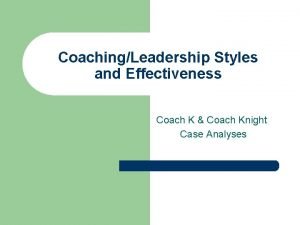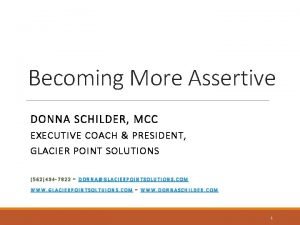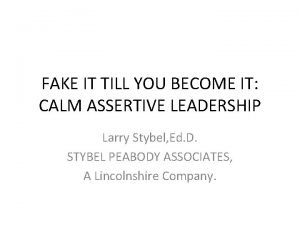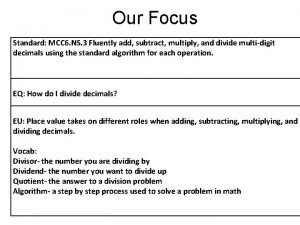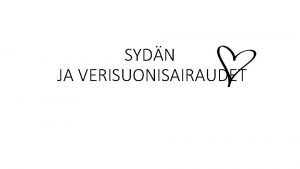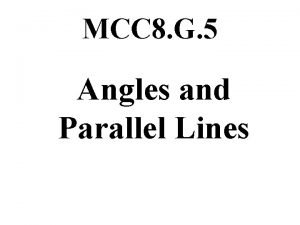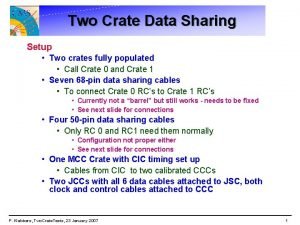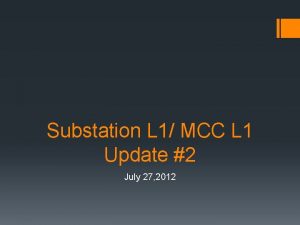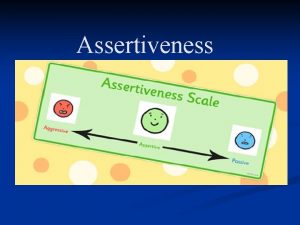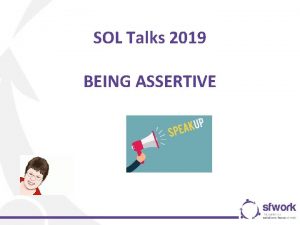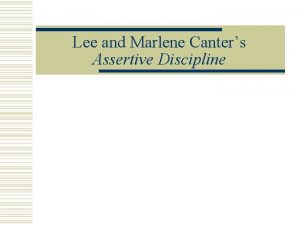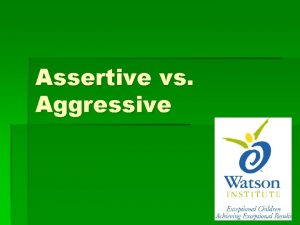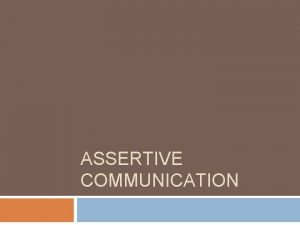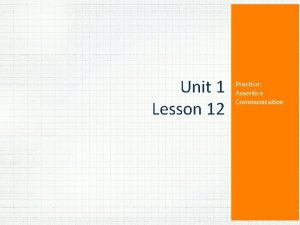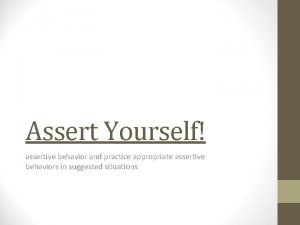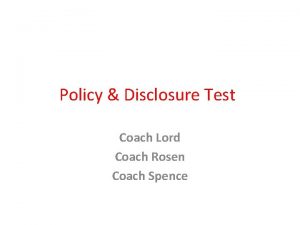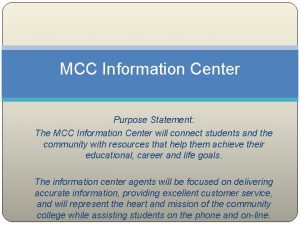Assertive Leadership DONNA SCHILDER MCC EXECUTIVE COACH PRESIDENT









































- Slides: 41

Assertive Leadership DONNA SCHILDER, MCC EXECUTIVE COACH & PRESIDENT, GLACIER POINT SOLUTIONS (562)434 -7822 ~ DONNA@GLACIERPOINTSOLUTIONS. COM WWW. GLACIERPOINTSOLTUIONS. COM ~ WWW. DONNASCHILDER. COM 1

Assertive Leadership Topics Understanding the Aggressive, Submissive, and Assertive approaches How to Shift to Using Assertive Posture, Gestures, Facial Expressions, and Voice Tone Choosing Assertive Words Adopting an Assertive Philosophy 2

NOTE: You may want to take these Quizzes before reviewing this material: Assertiveness Quiz 1 Assertiveness Quiz 2 3

Why Be More Assertive? Reduces conflict Reduces dissatisfaction Relieves stress 70% of firings result from an employee or leader being too aggressive Moving into a leadership role often requires a shift from a passive to assertive style 4

Why Be An Assertive Leader? Assertive leaders: ◦ Are motivating and inspiring ◦ Employees are happier (and more productive) following Assertive leaders ◦ Communicate more clearly ◦ Create productive, focused teams ◦ Are more able to create an innovating environment ◦ Are able to harness and/or diffuse conflict as appropriate ◦ Are rated higher on Employee Surveys 5

Why Be An Assertive Leader? Assertive leaders: ◦ Are better able to create collaborative teams ◦ Don’t create unnecessary employee turnover ◦ Employees often leave when they have an Aggressive Leader ◦ Avoid causing lawsuits ◦ Employees who leave may sue for a Hostile Workplace ◦ Are able to push back when others are making the wrong decisions or going in the wrong direction 6

The Assertiveness Continuum Assertive Passive Aggressive 7

Three Styles Passive Assertive Aggressive 8

Passive Indirect Inferior The victim Submissive The needs of others are more important than mine Lose-win Adapted from: Developing Positive Assertiveness, Sam R. Lloyd (Slides 5 -21) 9

Aggressive Can be active or passive Direct or indirect Superior The victor My needs are more important others needs Win-lose 10

Assertive Active Direct and specific Honest Self-respecting Respect for others My needs are equal to others’ needs Seeks the win-win solution 11

Assertive Approach Influencing Listening Negotiating (as equals) Partnering Collaborating Give and take 12

Assertiveness Philosophy I accept the communication styles of others I respect others and wish them well I offer win-win solutions I choose my communication style rather than reacting to others I accept responsibility for my feelings, thoughts, and opinions I can express my feelings and thoughts openly I let others express their feelings, thoughts, and opinions 13

Assertive Leaders: Communicate their expectations clearly Give honest feedback Look for win-win solutions Avoid reacting to others Intervene in negative behavior Create a safe environment Seek consensus Resolve conflict 14

You May Be Passive If You hesitate or apologize often when you speak You purposely avoid confrontations at all costs, even if it means losing money You easily blame yourself if something goes wrong, even if it’s not your or your team’s fault You make bold claims without anything to back them up You rely almost solely on the insights of others when you make decisions If yes, go to page: 17 15

You May Be Aggressive If You are constantly competitive You believe you are always right You respect very few people You trust few people You yell or raise your voice often You are often emotional You want everything done your way You do all the talking in meetings If yes, go to page: 27 16

Recognizing that Others Perceive You as Passive Others don’t look at you when you talk Others don’t listen to you Others don’t treat you with respect Your team doesn’t think you will represent their interests Your team has low morale Your peers go around you Your employees go above you Your peers are motherly towards you 17

Disadvantages of a Passive Leadership Style You may get ignored You may get sabotaged You may not represent the needs, interests, and requirements of your department or function well ◦ You may not get the resources you need ◦ Your department needs may not be made the priority they need to be You may not address resolve conflict or leverage it for greater collaboration ◦ Unresolved conflict may adversely impact productivity, creativity, and communication You may not share your innovative ideas 18

Posture – Passive to Assertive Passive Assertive Slumped Erect, but relaxed, shoulders straight Looking down Chin down Head straight Shifting back and forth Solid, grounded Being small Taking up space Sitting: feet behind knees Sitting: legs crossed or together 19

Facial Expression – Passive to Assertive Passive Assertive Pleading look Relaxed expression Rapid blinking Few blinks Blushing Caring look Nervous smile Genuine smile Chewing lower lip Relaxed mouth If angry, eyes averted 20

Voice Tone – Passive to Assertive Passive Assertive Quiet Appropriate loudness High pitched Pleasant Hesitation Firm Nervous laugh Even-flowing Statements that sound like questions Voice even when making statements Say “Uh” often 21

Gestures – Passive to Assertive Passive Assertive Shoulder shrugs Relaxed shoulders Head nodding Relaxed, head nodding to indicate listening Fluttering hands Casual hand movements, relaxed hands Open arms 22

Passive to Assertive Word Choice Acquiescing Be Direct, State Priorities I guess we could take that over This task that’s a higher priority Maybe you could help me? Indirect Requests Can you find the report? Defer to be Agreeable Whatever you want I can’t, I won’t I can’t give you my budget Please help me with this Direct Requests Please find the report for me State Preferences I prefer that you finish the task now Say “no” politely No, I’m not going give you my budget 23

Shifting from Passive to Assertive Thinking My needs (or my mandates) are as important as those of others I deserve to have my needs met I will ask for what I want or need I will embrace conflict and shift it to collaboration 24

Shifting from a Passive to Assertive Approach Stand tall and grounded ◦ Take deep breaths to calm and ground yourself Look others in the eye Seek the win-win Adopt an Assertive Philosophy 25

Shifting from Passive to Assertive Leadership With your Coach, examine beliefs that underly your approach Read the Passive to Assertive articles listed on the Assertive Leaders Page Overcome your fears Practice Assertive posture, facial Expression, voice tone, and gestures Role Play challenging situations Identify actions with your Coach If shifting from passive to assertive, go to page 40 26

Recognizing That Others Perceive You As Aggressive Others get small, look down, get tense when you are talking to them Others hesitate when they tell you something controversial, deliver bad news, or that might stir emotion in you The room goes quiet when you walk in Others look down instead of looking you in the eyes 27

Disadvantages to an Aggressive Leadership Style Employees don’t speak up with their ideas ◦ You loose good ideas Employees hide mistakes or negative circumstances ◦ You get blindsided ◦ You can’t create preventative measures ◦ You can’t help them correct the situation Employees don’t feel empowered, so they don’t solve problems on their own ◦ Solutions for customers are delayed An environment of fear blocks collaboration 28

Posture – Aggressive to Assertive Aggressive Assertive Rigid shoulders Erect posture, but relaxed, shoulders straight Looking down Looking straight ahead Looking away Looking into the other person’s eyes Chin thrust forward Head straight Tense Solid, grounded Leaning forward or over Taking up space Sitting: hands behind head Sitting: legs crossed or together Crossed arms (closed off posture) Open arms 29

Facial Expression – Aggressive to Assertive Aggressive Assertive Tight jaw Relaxed expression Glaring Few blinks Scowl Caring look Sarcastic smile Genuine smile Bare teeth Relaxed mouth Turning red Rolling eyes 30

Voice Tone – Aggressive to Assertive Aggressive Assertive Loud Appropriate loudness Harsh Pleasant Biting off words Firm Sarcastic laughter Even-flowing Statements that sound like orders Voice even when making statements 31

Gestures – Aggressive to Assertive Aggressive Assertive Sharp, dismissive shoulder gestures Relaxed shoulders Sharp, quick, dismissive nods Relaxed, head nodding to indicate listening Jerky hand movements Casual hand movements, relaxed hands Clenched hands Open, relaxed hands Pointing, chopping, jabbing Smooth hand gestures Sweeping arm gestures Open arms 32

Aggressive to Assertive Thinking I will respect the needs of others I can admit my mistakes or say “I don’t know” I can allow others to make mistakes It’s OK to trust others 33

Aggressive to Assertive Word Choice Use of Absolutes When you constantly interrupt Behavior Description When you interrupt me When you always forget to clean up your When you don’t clean up your workstation You’re never on time When you’re late You obviously don’t care When you laugh at me Judgmental Words When you hide my files Behavior Description When you don’t return my files When you overspend the clothing budget When you waste our hard-earned money on unnecessary clothes 34

Aggressive to Assertive Word Choice “You” Statements I believe, I think, I feel You’re interrupting me I would like to tell my story without You don’t think what I have to interruption say is important It, that, one It seems like you don’t trust me I believe you don’t trust me 35

Aggressive to Assertive Word Choice Exaggerating Be Realistic If you don’t change, you’ll be in real trouble If you continue to forget, I’ll tell your supervisor Sarcasm We wouldn’t want to strain your willpower This is the third time you’ve eaten a donut Depersonalizing Feelings Communicate Your Feelings You make me mad I feel angry That’s disappointing I am disappointed 36

Shifting from Aggressive to Assertive Thinking The needs of others are as important as my own A win-win solution means my needs are met as well as others’ needs are met Win-win solutions are good for the organization Others’ may have good solutions or approaches also I listen first to others, then I give my thoughts 37

Shifting From Aggressive to Assertive If you become excited or emotional: ◦ Take deep breaths before you speak ◦ Relax your body ◦ Take (or create) a break Sit side by side with the other person Don’t stand over the other person 38

Shifting from Aggressive to Assertive Leadership With your Coach, examine beliefs and fears that underly your approach Adopt an Assertive Philosophy Read the Aggressive to Assertive articles listed on the Assertive Leaders Page Choose and practice Assertive posture, facial Expression, voice tone, and gestures Role Play challenging situations Intervene when you feel yourself getting emotional Identify actions with your Coach 39

What Does a Relationship Look Like When You Are Assertive? The other person is attentive, cooperative, respectful. There are no signs of frustration, disregard, or defensiveness. The other person says: “OK, ” “Sure, ” “I’ll be glad to” with no signs of resentment or discomfort. Others are honest about thoughts, feelings, and opinions and communicate their wants and needs respectfully. ◦ They are assertive with you. 40

Assertive Leadership Summary Use Assertive Words, Gestures, and Voice Tone Convey a Direct and Appropriately Honest Message Adopt Affirmations to Develop an Assertive Philosophy Set Limits and Give Boundaries Ask for What You Need 41
 Donna schilder
Donna schilder Coach k leadership style
Coach k leadership style Assertive executive
Assertive executive Ducks unlimited checks
Ducks unlimited checks Microsoft executive briefing center
Microsoft executive briefing center The executive power shall be vested
The executive power shall be vested Executive office of the president
Executive office of the president True or false the executive branch is only the president
True or false the executive branch is only the president Executive office of the president
Executive office of the president Calm assertive leadership
Calm assertive leadership Schilder teszt
Schilder teszt Verandertaal uitlokken
Verandertaal uitlokken Noorderlinkdagen
Noorderlinkdagen Agnes schilder
Agnes schilder Bureau payroll specialisten
Bureau payroll specialisten Executive leadership seminars
Executive leadership seminars Executive ethical leadership reputation matrix
Executive ethical leadership reputation matrix Diversity executive leadership academy
Diversity executive leadership academy Police executive leadership college
Police executive leadership college Mcc 7
Mcc 7 Mcc moodle
Mcc moodle Tsahc loans
Tsahc loans Mcc coop
Mcc coop Mcc ota program
Mcc ota program Ihda mcc
Ihda mcc 6.ns.3
6.ns.3 Morbus coronarius cordis
Morbus coronarius cordis Ohfa mortgage tax credit
Ohfa mortgage tax credit What is m 4 if m 6 78
What is m 4 if m 6 78 Crate and barrel mcc
Crate and barrel mcc Conception
Conception Calhfa mcc
Calhfa mcc Los amigos de colores
Los amigos de colores Mcc
Mcc Mcc 6
Mcc 6 Nebraska paralegal association
Nebraska paralegal association Jwst mcc-1a
Jwst mcc-1a Mcc substation
Mcc substation Mcc today
Mcc today The exchange mcc
The exchange mcc Transactional vs transformational leadership
Transactional vs transformational leadership Adaptive leadership characteristics
Adaptive leadership characteristics

